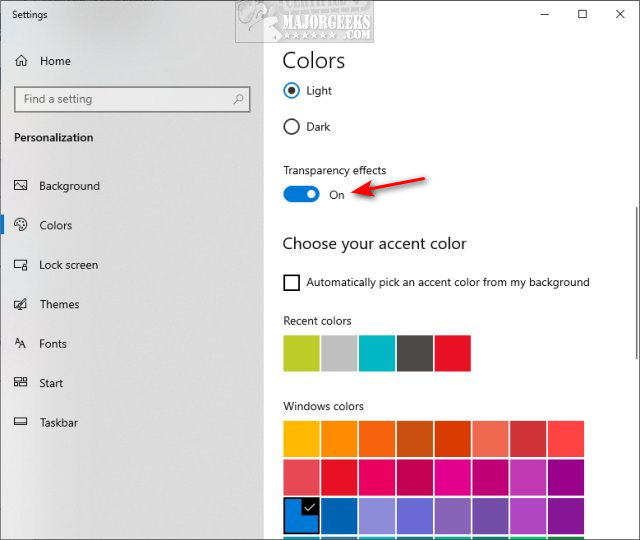
Introduction:
Windows 10, Microsoft’s feature-rich operating system, comes with a plethora of visual enhancements to provide users with a modern and appealing user interface. One such feature is transparency effects, which add a subtle see-through effect to certain interface elements, like the taskbar, Start menu, and window borders. While transparency effects can enhance the visual experience for many users, some may prefer a more streamlined and performance-focused interface. In this extensive guide, we will explore the intricacies of how to disable transparency effects in Windows 10, offering users the flexibility to tailor their operating system to their preferences and optimize performance.
Understanding Transparency Effects in Windows 10:
Transparency effects in Windows 10 are part of the operating system’s design language, aiming to create a visually engaging and cohesive user interface. These effects introduce a sense of depth by allowing users to see a subtle glimpse of what lies behind certain interface elements. While this feature is aesthetically pleasing for many users, some may find it distracting or prefer a more straightforward and high-performance visual style.
Benefits of Disabling Transparency Effects:
- Performance Optimization: Disabling transparency effects can lead to improved system performance, especially on older hardware or devices with limited graphical capabilities. This is particularly relevant for users who prioritize speed and responsiveness in their computing experience.
- Reduced Distractions: Some users find that the transparent elements create unnecessary visual distractions. Disabling transparency can provide a cleaner and more focused interface, minimizing potential distractions during work or leisure activities.
- Consistent Aesthetics: For users who prefer a consistent and flat visual style across all interface elements, disabling transparency effects ensures a uniform appearance throughout the operating system.
- Enhanced Readability: In certain scenarios, transparency effects can affect text readability or contrast. Disabling transparency may improve the overall legibility of text and graphical elements, especially for users with specific visual preferences.
Methods to Disable Transparency Effects in Windows 10:
Windows 10 provides multiple methods to disable transparency effects, ranging from built-in settings to more advanced options. Users can choose the method that best suits their preferences and technical comfort level. Below are three commonly used methods:
Method 1: Using Settings
- Open Settings:
- Click on the “Start” button and select the gear-shaped “Settings” icon to open the Settings app.
- Access Personalization Settings:
- In the Settings app, click on “Personalization.”
- Navigate to Colors:
- In the left sidebar, select “Colors.”
- Toggle Off Transparency Effects:
- Scroll down to the “Transparency effects” section.
- Toggle the switch to the “Off” position to disable transparency effects.
- Restart if Necessary:
- In some cases, a system restart may be required to apply the changes.
Method 2: Using System Properties
- Open System Properties:
- Press “Windows key + Pause/Break” to open the System Properties window.
- Access Advanced System Settings:
- In the System Properties window, click on “Advanced system settings” on the left.
- Open Performance Options:
- Under the “Advanced” tab, click on the “Settings” button within the “Performance” section.
- Adjust Visual Effects:
- In the Performance Options window, navigate to the “Visual Effects” tab.
- Find and uncheck the option for “Enable transparency.”
- Apply Changes:
- Click “Apply” and then “OK” to save the changes.
Method 3: Using Registry Editor
Warning: Editing the registry is a powerful and potentially risky operation. Proceed with caution and consider creating a backup before making any changes.
- Open Registry Editor:
- Press “Windows key + R” to open the Run dialog.
- Type “regedit” and press Enter to open the Registry Editor.
- Navigate to Personalization Key:
- In the Registry Editor, navigate to the following key:
HKEY_CURRENT_USER\SOFTWARE\Microsoft\Windows\CurrentVersion\Themes\Personalize
- In the Registry Editor, navigate to the following key:
- Create or Modify DWORD Value:
- Right-click on the right pane, select “New -> DWORD (32-bit) Value.”
- Name the new value “EnableBlurBehind.”
- Double-click on it and set its value to “0” to disable transparency.
- Restart Explorer:
- Press “Ctrl + Shift + Esc” to open Task Manager.
- Locate “Windows Explorer” in the process list, right-click it, and select “Restart.”
Considerations and Additional Tips:
- System Requirements:
- Users with higher-end hardware may not experience significant performance differences with transparency effects enabled. Consider the capabilities of your system when deciding whether to disable transparency.
- Regular Updates:
- Keep in mind that major Windows updates or changes to the operating system may impact transparency settings. After updates, review and adjust settings if necessary.
- Explore Third-Party Themes:
- For users seeking more extensive customization options, third-party themes and visual styles can be explored. However, caution is advised, as modifying system themes can have unintended consequences.
- Community Forums and Discussions:
- If you encounter challenges or have specific questions about disabling transparency effects, community forums and discussions can be valuable resources. Fellow users may provide insights and solutions based on their experiences.
Conclusion:
Disabling transparency effects in Windows 10 is a customization option that empowers users to tailor their operating system to their preferences and performance needs. Whether you choose to utilize the built-in settings, adjust options through the System Properties, or venture into the Registry Editor for more control, the methods outlined in this comprehensive guide cater to different user preferences and technical comfort levels. By following the step-by-step procedures and considering additional tips, users can achieve a visual style that aligns with their preferences and enhances the overall Windows 10 experience. Embrace the customization possibilities, optimize performance, and enjoy a streamlined interface that complements your computing journey.